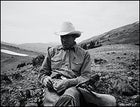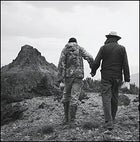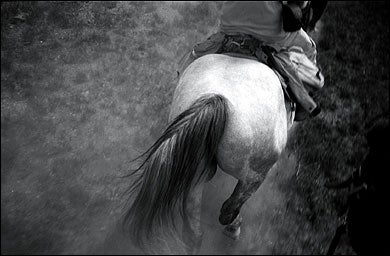SUNRISE IN TERRACE MEADOWS, in Wyoming’s Teton Wilderness, and I sit up, wrapped in my sleeping bag, trying not to disturb my sister, Anne, as I listen to our horses grazing nearby. We turned them loose for the night to forage, looping cowbells around their necks so we could find them again, and one bell jangles softly as a horse ambles closer to our tent. And closer. And closer. Wait a minute. Anne bolts up as the animal lets out a grunt and—oh, please, no—unleashes a torrent of liquid onto the canvas fly. We rush outside, screaming, and there’s Will, our stepbrother, grinning and holding an empty bucket in one hand and a cowbell in the other. “Mornin’!” he calls. “Coffee’s on!”
absaroka mountains, horseback riding

absaroka mountains, horseback riding
 Stable family: on horseback at Ferry Lake
Stable family: on horseback at Ferry Lakeabsaroka mountains, horseback riding

Welcome to my family trip.
Some families go to the beach. Mine—all 13 of us, ranging in age from 71 down to 9—headed for the backcountry. The idea, as my stepfather, Bill, envisioned it, was to decivilize us all, to continue the conservation indoctrination he’d begun on our farm in Nashville, Tennessee. From Turpin Meadows, our trailhead 45 miles northeast of Jackson, we’d make a weeklong, 66-mile loop up into the 11,000-foot Absaroka Range to the Continental Divide. It seemed the perfect place to jump into the wild: The 585,238-acre Teton Wilderness, one of the first designated, in 1964, is home to one of the most remote spots in the lower 48—the Upper Yellowstone River. More famously, in my family at least, this wilderness is home to the dreaded 10,500-foot Marston Pass. In 1987, Bill and Will navigated the steep scree trail down Marston in a whiteout, as a relatively gnarly photo on the piano attests. Two years later, my mother, Jane, completed her outdoors-wife training on Marston Pass, polishing up her riding, fishing, and hunting skills for life with Bill. She swore it was so steep that one year a man lost his entire pack string—and she cried with relief when she made it down. So our trip was something of a family pilgrimage.
As on every serious expedition, each team member was charged with an area of expertise: Mom would be the trip wildflower expert, while Bill’s daughter Karin would lead us in horseback yoga stretches. Will would teach fly-fishing and such survival skills as striking matches on the zipper of your pants, while his trainees, the grandkids—girls Katherine and Alex, both 12, Jake, 10, and Steele, 9—would be our experts on grizzlies and snakes. I was the geologist. We were also well aware that any successful expedition begins with careful provisioning. So we loaded one of the packhorses with Maker’s Mark.
We would have gone nowhere fast without a guide. Ours, Press Stephens, quickly became our hero. A tall, sun-flushed cowboy with a Martin pack guitar and fringe on his chaps, Press has guided for 33 of his 52 years; his buckskin gelding, Bucky, knows these trails better than any outfitter in three states. But the part that cinched the deal for us is that Press practices minimal-impact horsepacking, never leaving the herd in one place long enough to damage the mountain grasses or the soil. Whenever we stopped, we tied the horses to one another, bridle to saddle and nose to tail, instead of to trees; at night, we turned them loose, and when we broke camp, Press dispatched the boys for games of horse hockey, to scatter the piles of pucks. “The days are long gone when you had a camp full of old-timers who want to sit around a big fire and tie their horses to trees right next to them,” he says. “I can have 20 horses in this camp, and you’d never know it the next day.”
WE RODE LIKE a string of lost Mormons moving west: Press in front, a scrum of kids, and the rest snaking behind. My big Thoroughbred, Bojangles, had a thing for my brother-in-law Mark’s gray gelding, Sticker, and Bill’s mustang, Windy, liked to clop cozied up to his little bay girlfriend, Birdie, ridden by Bill’s daughter Liz. So we climbed back and forth over the South Fork of the Buffalo River in horse couples, crossing in hock-high water and breaking out of the forest into meadow grass up to their stomachs. The pack horses—each laden with 150 pounds of sleeping bags, tents, and supplies—ambled behind. Aspens gave way to pines, serviceberries, and sandhill crane tracks, which in turn gave way to livid pink monkey flower and golden eagles. Near South Fork Falls, a 60-foot chute, Press dismounted and did a push-up in a patch of miner’s lettuce, drinking straight from the cold spring beneath.
“Ladies and gentlemen,” Bill proclaimed on our first night, gesturing across a great swatch of stream-braided public land from Smokehouse Mountain, to our north, to Simpson’s Peak, behind us to the south, “welcome to Terrace Meadows. This land belongs to us and the generations that follow, and we’re delighted to be here.” We were. It was bitter cold, with cigars lit and Press and Karin’s husband, Robin, taking turns on the Martin, wailing out John Prine. Around us spread one of North America’s coolest ranges, as I’d read in my geology homework. The Absarokas were created 50 million years ago by the eruptions of an ancient volcanic range. Today that volcanic rock rolls in miles-long bald meadows thick with grizzlies, elk, and alpine lakes. Our third night, after six hours in the saddle, we hit one of these, Ferry Lake, literally, throwing our bowlegged selves off our horses and into the frigid square-mile oasis at about 10,500 feet. By being first into the snowmelt, Steele earned the rest of us as his personal assistants; by the end of the night he was thoroughly over-served in hand-delivered hot chocolate.
We celebrated Will’s 40th birthday there at Ferry Lake, in the shadow of the Continental Divide. Sipping Maker’s-and-snow from a tin cup, he collected his gifts: an elk-bone-and-string mobile, a chocolate eyeball, and a bowl of grizzly scat. The sky burned orange, heavy with smoke drifting from wildfires. Mars rose red in the east, as Bill, hair wild and beard stubbly, bellowed out Robert W. Service’s poem of Yukon lunacy, “The Cremation of Sam McGee,” with this uplifting line: “And I burrowed a hole in the glowing coal, and I stuffed in Sam McGee.” This was by no means the most frightening part of the evening.
It was geology night, and Press delivered such a shaking, hopping, eye-popping impersonation of the caldera blowing its lid—as it could again, say scientists studying the ominous bulge under Yellowstone Lake—that the boys demanded to sleep in their parents’ tents, safe from maniacs and lava.
We finally did make it to Marston Pass. We cantered out from Ferry Lake and headed six miles east, past grizzly day beds tromped out in the spruce and firs. In the end it didn’t look all that bad. In fact, as Press remarked to me, he didn’t know what the hell we were all talking about—the place was just another steep trail, in a wilderness of steep trails.
But after a week in the saddle, I was too far gone to care. We’d all move to Wyoming, I had decided, leaning into Bojangles’s mane as black clouds rolled over the Divide; I’d adopt mustangs and become a junior pack guide, and Will could teach the kids to rob trains. The outlaw fantasy was in full swing when, blessedly for Press, we loped back into Turpin Meadows. I figured he’d had enough of our clan, but then he looked up, rain dripping off his hat brim as the crew happily ate penne with pesto on a wet log, and paid us a rare compliment. “Your family,” he told us, “you’ve got it figured out.”
No, we agreed, it was the other way around.
Access + Resources
With 3,111,232 acres of designated wilderness, Wyoming’s backcountry is vast enough that sometimes only a horse will do. The following three outfitters practice low-impact horsepacking. Though Press Stephens may be retiring, the new owners of his business will still offer minimal-impact summer horsepacking trips in the ABSAROKA and WIND RIVER ranges and YELLOWSTONE NATIONAL PARK. Rates start at $250 per person per day (307-455-2250, e-mail sj@wyoming.com). H. A. Moore, Press’s cohort in bringing minimal-impact pack trips to Yellowstone, offers fishing and adventure trips for four or more days in the park’s remote backcountry, including the THOROFARE area and cutthroat-choked LAMAR RIVER (from $280 per person per day for groups of four or more; Rendezvous Outfitters, 800-565-7110). Paintrock ���ϳԹ���s stalks golden, brown, and cutthroat trout from base camps in the CLOUD PEAK WILDERNESS. Five-day pack trips run $1,295 per person (307-469-2274, ).


